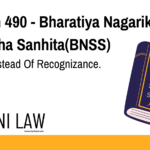Code: Section 491 BNSS
(1) Where,—
(a) a bond under this Sanhita is for appearance, or for production of property,
before a Court and it is proved to the satisfaction of that Court, or of any Court to
which the case has subsequently been transferred, that the bond has been forfeited; or
(b) in respect of any other bond under this Sanhita, it is proved to the satisfaction
of the Court by which the bond was taken, or of any Court to which the case has
subsequently been transferred, or of the Court of any Magistrate of the first class,
that the bond has been forfeited,
the Court shall record the grounds of such proof, and may call upon any person bound by
such bond to pay the penalty thereof or to show cause why it should not be paid.
Explanation.—A condition in a bond for appearance, or for production of property,
before a Court shall be construed as including a condition for appearance, or as the case
may be, for production of property, before any Court to which the case may subsequently
be transferred.
(2) If sufficient cause is not shown and the penalty is not paid, the Court may proceed
to recover the same as if such penalty were a fine imposed by it under this Sanhita:
Provided that where such penalty is not paid and cannot be recovered in the manner
aforesaid, the person so bound as surety shall be liable, by order of the Court ordering the
recovery of the penalty, to imprisonment in civil jail for a term which may extend to six
months.
(3) The Court may, after recording its reasons for doing so, remit any portion of the
penalty mentioned and enforce payment in part only.
(4) Where a surety to a bond dies before the bond is forfeited, his estate shall be
discharged from all liability in respect of the bond.
(5) Where any person who has furnished security under section 125 or section 136 or
section 401 is convicted of an offence the commission of which constitutes a breach of the
conditions of his bond, or of a bond executed in lieu of his bond under section 494, a
certified copy of the judgment of the Court by which he was convicted of such offence may
be used as evidence in proceedings under this section against his surety or sureties, and,
if such certified copy is so used, the Court shall presume that such offence was committed
by him unless the contrary is proved.
Explanation of Section 491 BNSS
Section 491 of the Bharatiya Nagarik Suraksha Sanhita (BNSS) establishes the procedure for handling forfeited bonds. When a bond for appearance or property production is forfeited, the Court can demand the payment of the penalty. If the penalty is not paid, the Court may recover it like a fine. If this isn’t possible, the surety could face imprisonment in civil jail for up to six months.
The Court may also reduce the penalty and enforce partial payment if justified. If a surety dies before the bond is forfeited, the surety’s estate is free from responsibility for the bond. Moreover, the law allows using the conviction of the person who provided security as evidence in proceedings against the surety.
Illustration
Example 1: Forfeited Bond for Appearance
A defendant does not appear in Court despite giving a bond for appearance. The Court proves the bond is forfeited and asks the defendant to pay the penalty or explain why they shouldn’t.
Example 2: Imprisonment Due to Non-Payment of Penalty
A surety cannot pay the penalty after a bond is forfeited. The Court orders the recovery of the penalty, and if it cannot be recovered, the surety may be imprisoned in civil jail for up to six months.
Example 3: Death of Surety Before Forfeiture
A surety dies before the bond they guaranteed is forfeited. In this case, the surety’s estate is no longer liable for the bond.
Common Questions and Answers on Section 491 BNSS
1. What happens if a bond is forfeited under Section 491?
- Answer: If a bond is forfeited, the Court can order the person to pay the penalty. If they fail to do so, the Court may recover it as a fine or imprison the surety for up to six months.
2. Can the Court reduce the penalty of a forfeited bond?
- Answer: Yes, the Court may reduce the penalty and enforce partial payment if it provides reasons for doing so.
3. What happens if the surety dies before the bond is forfeited?
- Answer: If the surety dies before the bond is forfeited, their estate is discharged from any liability regarding the bond.
4. Can the conviction of a person who furnished security be used in proceedings under Section 491?
- Answer: Yes, a certified copy of the conviction of the person who provided security can be used as evidence in proceedings under Section 491, and the Court may assume the offence was committed unless proven otherwise.
Conclusion
Section 491 BNSS provides clear steps to manage forfeited bonds, ensuring accountability from both the individual bound by the bond and the surety. The Court can demand payment of the penalty, impose partial penalties, or imprison the surety in civil jail if the penalty isn’t paid. This structured approach maintains fairness and transparency when handling forfeited bonds.











